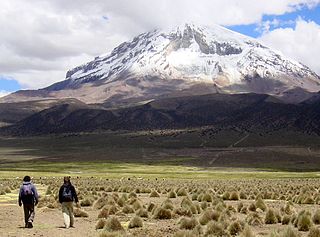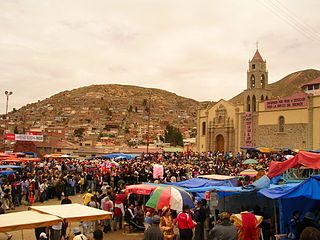
Patilla Pata is a stratovolcano in the Oruro Department in Bolivia. It is situated in the Sajama Province, in the west of the Curahuara de Carangas Municipality, at the border with Chile. Patilla Pata lies south-west of the mountain Jisk'a Kunturiri, north-east of the lake Q'asiri Quta (Khasiri Kkota) and the mountain Qullqi Warani, west of the little lake Sura Pata, south-east of the mountains Laram Q'awa, Kunturiri and Milluni and south of the little lake named Ch'iyar Quta.

Sajama is a province in the northwestern parts of the Bolivian Oruro Department.

Turco Municipality is the second municipal section of the Sajama Province in the Oruro Department in Bolivia, and was founded on February 15, 1957. Its seat is Turco, situated 154 km west of Oruro at an altitude of 3,860 m. The municipality covers an area of 3,973 km², not taking into account the area of Laca Laca Canton.
Pichacani or Pichaqani is one of fifteen districts of the Puno Province in the Puno Region in Peru.

Ch'iyar Quta is a small Bolivian lake located in the Sajama Province of the Oruro Department near the border to Chile. It is situated at a height of about 5,090 meters inside the boundaries of the Sajama National Park. Ch'iyar Quta lies south-east of the peaks of Laram Q'awa, Milluni and Kunturiri, south-west of Jisk'a Kunturiri and north of Patilla Pata.

Laram Q'awa is a 5,182-metre-high (17,001 ft) mountain in the Andes. According to the Bolivian IGM map 1:50,000 'Nevados Payachata Hoja 5739-I' it is situated on Bolivian terrain in the La Paz Department, Pacajes Province, at the border with Chile. It lies north-west of the mountains Kunturiri, Phaq'u Q'awa and another mountain on the border named Laram Q'awa (Laram Khaua). One of three different rivers of this area called Kunturiri (Condoriri) originates north-east of the mountain near Phaq'u Q'awa. It flows in a bow along the northern slopes of Laram Q'awa towards Chile.

Sura K'uchu is a region in the Cordillera Occidental in the Andes of Bolivia. It is located in the Oruro Department, Sajama Province, Turku Municipality, Chachakumani Canton. Sura K'uchu is situated south-east of the Uqi Uqini volcano and north-east of the volcano Umurata. It lies south of National Route 4 near the Chungara-Tambo Quemado pass. The river Jaruma originates here. It flows to the north-east as an affluent of the Sajama River.

Pumuta is a mountain in the Andes of Bolivia, about 5,200 metres (17,060 ft) high. It is situated in the Oruro Department, Sajama Province, Curahuara de Carangas Municipality, Sajama Canton, north-west of the extinct Sajama volcano. Pumuta lies south-west of the mountain Jach'a Kunturiri and north-east to east of the mountains Kunturiri and Jisk'a Kunturiri.

Phaq'u Q'awa is a 5,252-metre-high (17,231 ft) mountain in the Andes. According to the Bolivian IGM map 1:50,000 'Nevados Payachata Hoja 5739-I' it is situated on Bolivian terrain in the La Paz Department, Pacajes Province, Charaña Municipality, at the border with Chile. Phaq'u Q'awa lies north-west of the mountain Kunturiri and south-east of the mountain Laram Q'awa. The nearest peak to the east is Jaruma. One of three different rivers of this area called Kunturiri (Condoriri) originates north of the mountain. It flows in a bow along the northern slopes of Laram Q'awa towards Chile.

Qullqi Warani is a mountain in the Oruro Department in Bolivia at the border with Chile, north-west of the extinct Sajama volcano. It is situated in the Sajama Province, in the west of the Curahuara de Carangas Municipality. According to the Bolivian IGM map 1:50,000 'Nevados Payachata Hoja 5739-I' it lies entirely on Bolivian terrain. Qullqi Warani lies south-west of the mountains Jisk'a Kunturiri and Patilla Pata, north of Phaq'u Q'awa and south-east of Kunturiri. The little lakes Q'asiri Quta (Khasiri Kkota) and Sura Pata (Sora Pata, Sorapata) lie at its feet, east and north of it.

Wila Qullu is a mountain in the Oruro Department in the Andes of Bolivia, about 5,140 metres (16,864 ft) high. Wila Qullu is situated in the Sajama Province, in the west of the Curahuara de Carangas Municipality, west of the extinct Sajama volcano and north-east of the Paya Chata mountains. It lies south-west of the mountain Phaq'u Q'awa.

Phaq'u Q'awa is a 5,203-metre-high (17,070 ft) mountain in the Cordillera Occidental in the Andes of Bolivia. It is situated in the Oruro Department, Sabaya Province, Sabaya Municipality. Phaq'u Q'awa lies southeast of Wila Qullu.

Chilli Qhata is a 4,803-metre-high (15,758 ft) mountain in the Andes of Bolivia. It is situated in the Oruro Department, Sajama Province, at the border of the Curahuara de Carangas Municipality and the Turco Municipality. Chilli Qhata lies south-west of the mountain Q'aysiri and east of Janq'u Jaqhi.

Wisalla is a 5,031-metre-high (16,506 ft) mountain in the Andes of Bolivia. It is situated in the Oruro Department, Sajama Province, Curahuara de Carangas Municipality. Wisalla lies south-west of the dormant Sajama volcano.

Jach'a K'uchu is a mountain in the Andes of Peru, about 5,200 metres (17,060 ft) high. It is located in the Moquegua Region, Mariscal Nieto Province, Carumas District, and in the Puno Region, El Collao Province, Santa Rosa District. It lies southwest of Qiwña Milluku and northwest of Kurawara (Curahuara). The Janq'u Jaqhi River originates on the east side of the mountain. It flows to the southeast.

Phaq'u Q'awa is a 4,796-metre-high (15,735 ft) mountain in the Andes of southern Peru. It is located in the Moquegua Region, Mariscal Nieto Province, Carumas District, and in the Tacna Region, Candarave Province, Candarave District. It lies west of a lake named Aqhuya Ch'alla and southeast of Wila Wilani.

Pacocahua is a mountain in the Andes of Peru, about 5,000 metres (16,404 ft) high. It is situated in the Puno Region, El Collao Province, Santa Rosa District, and in the Puno Province, Acora District. It lies south of Coline and southeast of Arichua.

Taypi Qullu is a 4,684-metre-high (15,367 ft) mountain in the Andes of Bolivia. It is located in the Oruro Department, Sajama Province, Turco Municipality, near Junt'u Uta. Taypi Qullu lies northeast of Asu Asuni.

Janq'u Laqaya is a mountain in the Andes of Bolivia which reaches a height of approximately 4,300 m (14,100 ft). It is located in the Oruro Department, Sajama Province, Curahuara de Carangas Municipality, south of Ch'apiri.

Ch'apiri is a 4,302-metre-high (14,114 ft) mountain in the Andes of Bolivia. It is located in the Oruro Department, Sajama Province, Curahuara de Carangas Municipality. It lies east of a village of that name. The Ch'apiri River originates at the mountain.. It flows to Curahuara de Carangas in the north.












